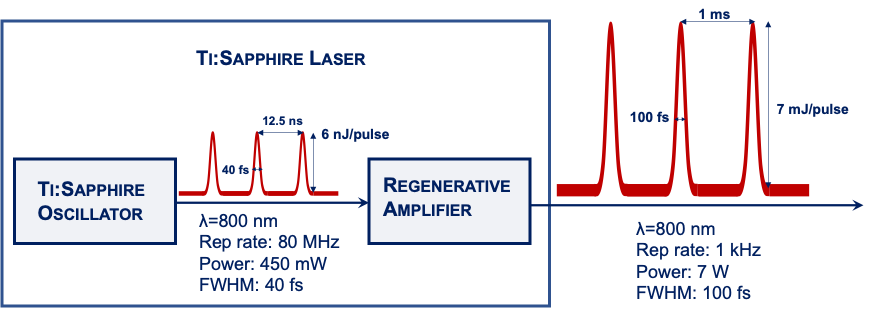Ti:Sapphire laser is an instrument that generates very short (~100 fs) pulses of coherent red light (λ~800 nm). The short pulses of light are spaced at 1 ms intervals (1 kHz repetition rate). Our eyes cannot distingush these individual pulses, because we cannot resolve signals that arrive faster than 30-60 Hz. So, the output of the Ti:Sapphire laser looks like a continuous beam, even though it is composed of individual pulses. Each short pulse is very intense (7 mJ/pulse): more than 28,000,000,000,000,000 (28 quadrillion) photons are grouped together into a pulse with duration of 0.0000000000001 seconds! Such high intensity and short time duration are essential for applications in ultrafast laser spectroscopy: high intensity enables nonlinear processes, which allow us to convert 800 nm light to other wavelengths of interest. High intensity pulses also ensure that a large fraction of exposed sample is converted into excited state. Short pulse duration allows studies of short-lived reaction intermediates in photochemical reactions.

Figure 1: Layout of a Ti:Sapphire Laser used in the Glusac lab. It consists of two components: (i) Ti:Sapphire oscilator, which produces ultrashort, but relatively weak laser pulses, and (ii) Regenerative amplifier, which increases the intensity of laser pulses.
The layout of a typical Ti:Sapphire laser is shown in Figure 1. It consists of two components: Ti:Sapphire oscillator and regenerative amplifier. Ti:Sapphire oscillator generates very short (40 fs) pulses of 800 nm light. Short pulses are generated using mode-locking, a technique in which the phases of each photon are matched to enable short pulse generation. However, the output intensity from Ti:Sapphire oscillator is relative low (6 nJ/pulse or 24 billion photon per pulse). For applications in pump-probe spectroscopy, the intensity of laser pulses needs to be higher than that. For this reason, the output from Ti:Sapphire oscillator is sent to the renegerative amplifier, where the intensity of pulses is increased million times. Regenerative amplification is achieved using chirped-pulse amplification, where the crystal damage due to high intensity is avoided by stretching the pulse before amplification, followed by its compression after they have been amplified. Chirped-pulse amplification was discovered by Gérard Mourou and Donna Strickland (Physics Nobel Prize, 2018).